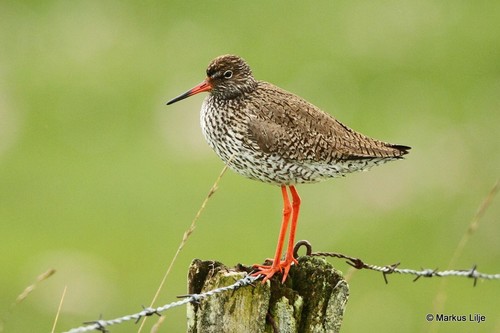
Common Redshank
The Common Redshank (Tringa totanus) is a widespread Eurasian wading bird known for its bright red legs and its loud, piping alarm calls, which have earned it the nickname "sentinel of the marshes." It plays a crucial role in wetland ecosystems, primarily as a predator of invertebrates. While not globally threatened, some populations face significant challenges due to habitat loss and other anthropogenic pressures. The Redshank is not typically associated with strong cultural symbolism, but its conspicuous presence and distinctive calls make it a familiar and easily recognizable bird across its range.
24-28 cm
Length
47-53 cm
Wingspan
Least Concern
Conservation Status
Distribution
The Common Redshank breeds across much of Eurasia, from Iceland and the British Isles in the west to eastern Siberia and China. It migrates south for the winter, reaching coastal regions of Africa, the Middle East, the Indian subcontinent, and Southeast Asia. Altitudinal range extends from sea level to upland moorlands and grasslands during the breeding season.
Lifespan
The average lifespan in the wild is around 5-10 years, but individuals have been recorded living over 20 years.
Common Redshank's Habitat
Habitat Types
Coastal saltmarshes, Estuaries, Mudflats, Inland wetlands, Wet grasslands, Upland moorlands (breeding season)
Climate Zones
Temperate, Boreal, Subarctic, Mediterranean
Adaptations
The Redshank's long legs and bill are adaptations for wading and probing in soft substrates for prey. Its relatively long toes help distribute its weight, preventing it from sinking into mud. They are also known to be relatively tolerant of brackish water conditions.
Variations
Several subspecies are recognized, differing slightly in plumage and size. For example, *T. t. robusta* (Iceland and the Faroe Islands) is generally larger and darker than *T. t. totanus* (mainland Europe).
Appearance
Breeding Plumage
Breeding plumage is generally mottled brown and grey above, with streaked underparts. Non-breeding plumage is paler and greyer, with less streaking. The legs are bright red year-round, although they can appear duller in non-breeding plumage.
Seasonal Feather Changes
The most significant seasonal variation is the change between the more heavily patterned breeding plumage and the paler, less distinct non-breeding plumage.
Sex Based Plumage Differences
Sexual dimorphism in plumage is minimal; males and females are very similar in appearance.
Notable Features
Bright red legs, White trailing edge to the wing, visible in flight, White rump and lower back, Long, straight, reddish bill with a dark tip
Diet and Feeding
Primary Foods
Insects, Crustaceans, Mollusks, Worms, Small fish (occasionally)
Foraging Behavior
Redshanks typically forage by probing in soft mud or shallow water with their bills. They may also pick prey from the surface or chase insects on foot. They are often seen actively running and probing along the water's edge.
Specializations
Their bill is slightly sensitive at the tip, allowing them to detect prey buried in the substrate. Their long legs allow them to wade in deeper water than many other small waders.
Seasonal Diet Variations
During the breeding season, their diet may consist more heavily of insects, while in winter, they may rely more on marine invertebrates like crustaceans and mollusks.
Behavior
Social Structure
Redshanks are often found in small flocks outside the breeding season, sometimes numbering in the hundreds or even thousands at particularly rich feeding grounds. During the breeding season, they are more territorial.
Communication
Loud, piping alarm calls ('teu-h-h-h'), Softer contact calls, Wing-lifting displays (visual communication)
Migration
Many populations are migratory, undertaking long journeys between breeding and wintering grounds. Some populations, particularly in western Europe, are more sedentary.
Territorial or Group Behaviors
During the breeding season, males defend territories against rivals. Outside the breeding season, they are generally more gregarious, forming flocks at feeding and roosting sites.
Conservation
Threats
Habitat loss and degradation (due to drainage, coastal development, and pollution), Climate change (sea-level rise affecting coastal habitats), Disturbance from human activities (recreation, hunting), Changes in agricultural practices
Protection Programs
International agreements (e.g., the African-Eurasian Waterbird Agreement (AEWA)), Designation of protected areas (e.g., Ramsar sites, Special Protection Areas), Habitat restoration projects
Local National Laws
Protected under various national wildlife legislation in many countries within its range.
Population Trend
Overall, the global population trend is considered stable, but some regional populations are declining.
Population Estimates
The global population is estimated to be between 590,000 and 1,900,000 individuals.
Interesting Facts
They are known for their nervous behavior.
Redshanks are often the first birds to take flight and sound the alarm when disturbed, alerting other birds in the area.
They can swim.
Although primarily waders, Redshanks are capable of swimming, particularly when chicks are threatened.
Their red legs become brighter during the breeding season.
The intensity of the leg color is thought to be related to breeding condition.
They sometimes nest in loose colonies.
While territorial, multiple pairs may nest in relatively close proximity in areas with good nesting habitat.
Faqs about Common Redshank
Why are they called Redshanks?
The name 'Redshank' refers to their distinctive bright red legs.
Where can I see a Redshank?
Redshanks are found in a variety of wetland habitats, including coastal saltmarshes, estuaries, and mudflats. They are widespread across Eurasia and parts of Africa.
What do Redshanks eat?
They eat a variety of invertebrates, including insects, crustaceans, mollusks, and worms. They find their prey by probing in mud or shallow water.
Are Redshanks endangered?
The Common Redshank is classified as 'Least Concern' by the IUCN, meaning it is not currently considered globally threatened. However, some populations are facing declines due to habitat loss and other factors. *Consult a professional for expert advice on bird conservation.*
Copyright @ Nature Style Limited. All Rights Reserved.
 English
English